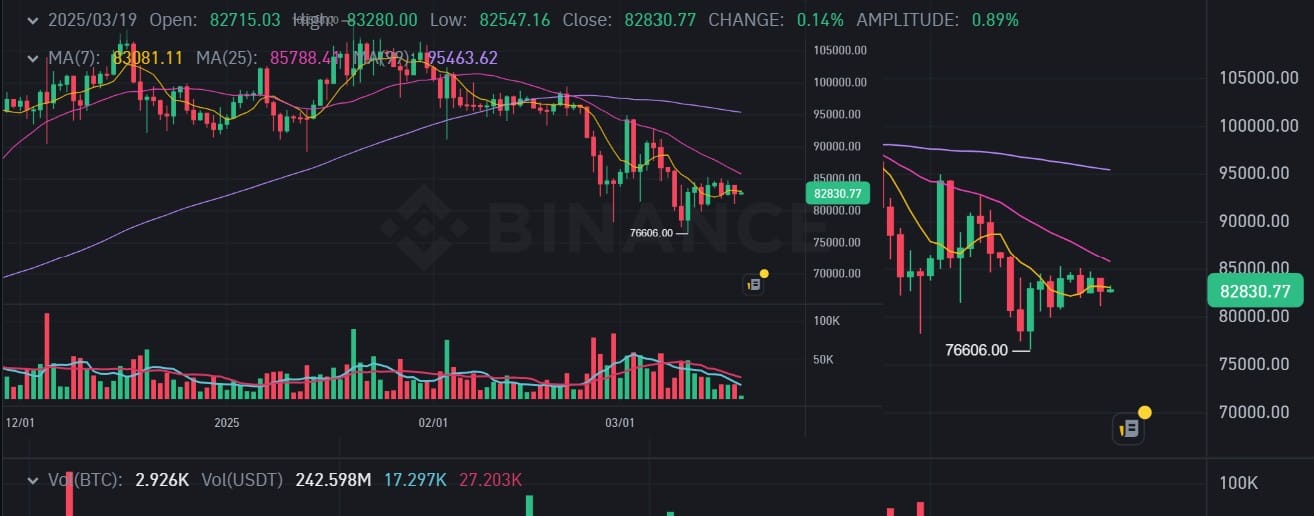When to Sell Bitcoin: A Strategic Guide for Maximizing Profits
Knowing when to sell Bitcoin is key to maximizing profits. This guide covers market trends, technical analysis, and exit strategies to help you sell at the right time. Learn how to use RSI, moving averages, and profit-taking techniques to avoid losses and secure gains.

Bitcoin’s price swings can be thrilling, but knowing when to sell Bitcoin is where real profits are made. Selling too early means missing out on potential gains, while waiting too long could lead to losses. Whether you're a seasoned trader or a long-term holder, understanding the right exit strategy is crucial.
In this guide, we’ll break down essential Bitcoin selling strategies, covering key market signals, technical analysis, and profit-taking techniques. By the end, you'll have a clear roadmap to decide the best time to sell BTC and maximize your investment returns.
Key Indicators to Know When to Sell Bitcoin
Selling Bitcoin at the right time requires a mix of market awareness, technical analysis, and strategic planning. Here are the most critical factors to consider:
1. Market Trends and Bitcoin Price Prediction
Understanding market trends helps determine the best time to sell BTC. Analysts use Bitcoin market analysis to predict future prices based on historical data and economic factors.
- Bullish trends: If Bitcoin is on a steady rise, it may be worth holding longer.
- Bearish trends: A downward trend signals potential losses, making it a good time to sell.
- News and regulations: Government policies and institutional investments can heavily influence price movements.
2. Technical Analysis for Bitcoin Exit Strategy
Charts and indicators help traders decide when to sell Bitcoin. Some key metrics include:
- Relative Strength Index (RSI): If RSI is above 70, Bitcoin is overbought and might correct downward.
- Moving Averages: When the price crosses below a key moving average, it may signal a sell opportunity.
- Support and Resistance Levels: If Bitcoin struggles to break past a resistance level, it might be time to sell.
3. Setting Profit Targets with Bitcoin Profit-Taking Strategies
A solid Bitcoin selling strategy includes profit targets to lock in gains. Common approaches include:
- Fixed Percentage Profit-Taking: Selling after a set percentage gain (e.g., 50%-100%).
- Trailing Stop-Loss: Automatically selling if Bitcoin drops by a certain percentage after reaching a high.
- Portfolio Rebalancing: Selling Bitcoin to maintain a balanced crypto investment portfolio.
Signs of Market Overvaluation: Should I Sell My Bitcoin Now?

Knowing when to sell Bitcoin depends on recognizing an overheated market. Several factors indicate Bitcoin might be overvalued:
- Extreme Greed in Market Sentiment: The Fear & Greed Index helps gauge investor emotions. If it reaches "Extreme Greed," Bitcoin may be in a bubble.
- Parabolic Price Movements: A rapid, unsustainable price surge often leads to a sharp correction.
- High Funding Rates in Futures Markets: When long positions dominate, a price drop can trigger liquidations, causing Bitcoin to fall.
Bitcoin Technical Analysis: When to Sell Bitcoin Based on Market Trends
Technical indicators provide insights into Bitcoin’s price movements, helping traders decide when to sell Bitcoin. Key metrics to watch include:
- Relative Strength Index (RSI): If RSI is above 70, Bitcoin is overbought, signaling a potential drop.
- Moving Averages (MA): When Bitcoin’s price falls below the 50-day or 200-day moving average, it suggests a downtrend.
- Support and Resistance Levels: If Bitcoin struggles to break resistance or falls below key support, it may be time to sell.
Economic and Regulatory Factors Affecting Bitcoin Selling Strategies
Bitcoin’s price reacts to economic policies and government regulations. Understanding these influences helps shape a Bitcoin exit strategy:
- Interest Rate Hikes: Higher rates make traditional assets more attractive, leading to Bitcoin sell-offs.
- Regulatory Crackdowns: Stricter crypto laws can reduce demand and impact Bitcoin’s long-term value.
- Institutional Sell Pressure: If major investors start offloading Bitcoin, it could signal an incoming downtrend.
Bitcoin Exit Strategy: How to Plan Your Sell-Off for Maximum Profit
A well-planned Bitcoin exit strategy ensures you sell at the right time and lock in profits. Instead of reacting to price swings, follow these steps:
- Set Profit Targets: Decide in advance at what price you’ll sell portions of your holdings. For example, sell 25% at 2x your buy price, another 25% at 3x, and so on.
- Use Stop-Loss Orders: Protect your investment by setting automatic sell orders if Bitcoin drops to a certain level.
- Sell in Phases: Instead of selling all at once, cash out gradually to maximize gains while reducing risk.
- Monitor Market Conditions: Stay updated on Bitcoin price prediction trends and adjust your strategy if needed.
Common Mistakes to Avoid When Selling Bitcoin
Selling Bitcoin at the wrong time can cost you potential profits. Avoid these common mistakes to make better decisions.
- Emotional Selling: Many traders panic during market dips and sell too early. Instead, rely on Bitcoin market analysis and trends before deciding.
- Ignoring Tax Implications: Selling Bitcoin triggers capital gains tax in many countries. Plan your exit with tax efficiency in mind.
- Failing to Set a Strategy: Without a clear Bitcoin exit strategy, you might sell too soon or too late. Set targets and use stop-loss orders.
- Overreacting to News: Sudden headlines can cause price swings. Instead of reacting instantly, check multiple sources and assess the long-term impact.
- Selling During Low Liquidity: Selling when trading volume is low can lead to slippage, reducing your profits. Aim to sell when market activity is high.
Conclusion
Knowing when to sell Bitcoin is a crucial aspect of navigating the cryptocurrency market successfully. By utilizing tools like Bitcoin technical analysis, monitoring Bitcoin price predictions, and employing Bitcoin profit-taking strategies, you can make informed decisions that align with your financial goals. Remember, Bitcoin market analysis and exit strategies are your best allies in identifying the right moment to sell and secure profits.
As with any investment, timing is key. Stay informed, stick to your plan, and don’t rush your decisions. By integrating these strategies into your investment routine, you can maximize your returns and confidently know when to sell Bitcoin.
FAQs
When is the best time to sell Bitcoin?
The best time to sell Bitcoin depends on several factors, such as Bitcoin price prediction, market trends, and your personal investment goals. A general rule of thumb is to sell when you have reached your target profit, or if market analysis indicates a downturn. Regular Bitcoin technical analysis can help you stay informed.
How do I know when to sell Bitcoin for profit?
One key factor to consider is the price relative to your purchase point. When Bitcoin reaches your target price or shows signs of reversal in market analysis, it might be time to sell. Using profit-taking strategies like setting a stop-loss order can help secure gains.
Should I sell my Bitcoin now?
If you’re wondering, "Should I sell my Bitcoin now?" consider recent Bitcoin market analysis and any new developments like market sentiment shifts. A well-timed decision can often be based on Bitcoin technical analysis, understanding price movement, and overall trends.
How can I avoid regret after selling Bitcoin?
To prevent the seller's remorse, make sure your selling decision is backed by data, such as Bitcoin exit strategies and market patterns. By relying on strategic Bitcoin selling strategies, you can ensure your decision is well thought out and not driven by impulse.
